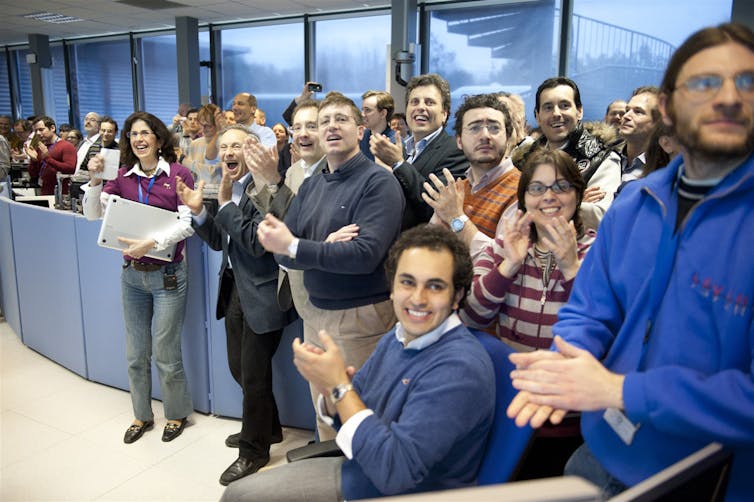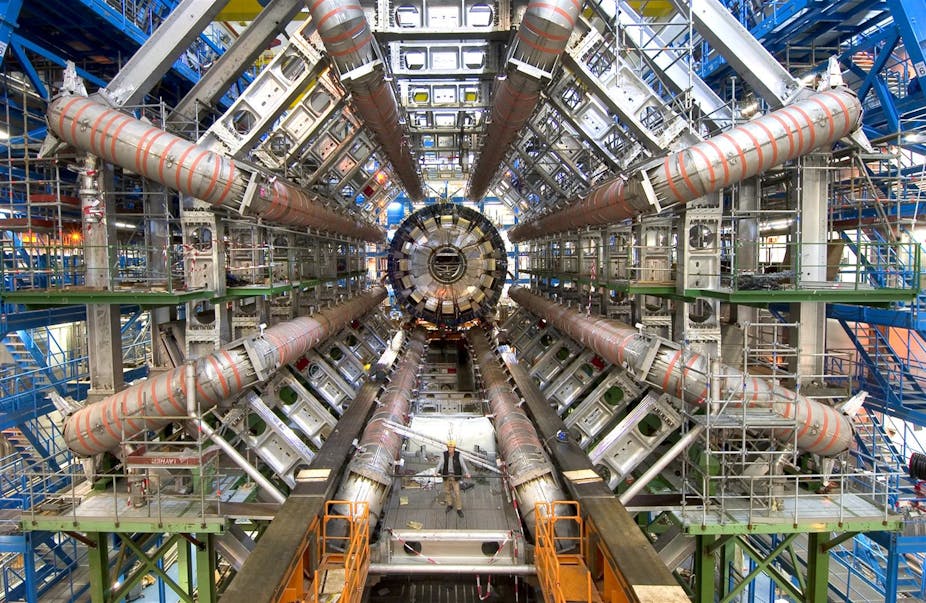The challenge for the documentary filmmaker is to persuade the viewer to take the images and sounds with which they are presented for the world itself. The documentary viewer willingly collaborates in this project because we want to see what’s real. So for the filmmaker, the challenge really becomes how not to make a mess of things, how not to make it difficult for the viewer to believe that what they see and hear really is the case.
This is where organising the documentary text as a story becomes problematic, for at some level we all sense that stories are artificial. Of course stories are also wonderful because they make sense of things; they hold our interest as life does not. Consequently a great many documentaries are structured as stories. Science documentaries, forever seeking popular appeal, almost always are.
Particle Fever is a feature length science documentary, showing at various film festivals this summer. It is a fine example of this tendency. The film tells the gripping story of the enormous collaborative effort to find and take the measure of the Higgs, the elusive sub-atomic particle considered by scientists the “lynch-pin” of the so-called “Standard Model”, the name given by physicists to their current understanding of the nature of matter and the universe. The film focuses mainly on the feverish final weeks of the 30 year project, and climaxes with the return of the experiment’s first results on July 4th 2012.
A lot hinges, we are told, on the success of this multi-billion dollar experiment. If the Higgs is not found, then Science’s understanding of things must be deeply wrong. But with the particle in hand, scientists will be able to decide a profound dispute: whether the universe is a beautifully ordered place ruled by universal laws, or a chaotic place where the values of things such as the speed of light are essentially random, a place where doing physics is therefore pretty pointless.
Although their dramatis personae may vary, stories have a highly conventional form and Particle Fever is no exception. In this film, a series of heroes are dispatched from the village of Science to bring home what is lacking (the Higgs). Each incarnation of the hero is aided in their quest by the magical “five storey Swiss watch” that is the Large Hadron Collider at CERN. Sometimes the heroes are frustrated by villains (mostly in the form of gremlins in the machinery) but ultimately they overcome these and other challenges and return home with the coveted prize to receive their reward.
This triumphant return is set to Beethoven’s Ode to Joy. No doubt the assembled thousands at CERN, many of whom had dedicated years to the project, felt joyful at the proper functioning of their remarkable machine. You’d have to have a heart of stone not to share their emotion. But once the moment has passed a different feeling sets in, a feeling, dare I say it, of emptiness. The narrative has run its course and for the layperson at least we are left wondering what it all adds up to. What have we really seen?

There is a telling moment early on in the film that suggests an explanation for this feeling. The physicist David Kaplan is describing the project at a conference. When he finishes he invites questions from his audience. A self-avowed economist pipes up asking him to justify the cost – what benefits will it bring? Kaplan sweeps the question aside with a spurious comparison to Hertz’s discovery of radio waves, which, like the Higgs, had no obvious application at the time.
Of course Kaplan has a perfect right to sidestep the economist’s challenge, but this is the only part of the Q & A the editor, Apocalypse Now’s Walter Murch, chose to leave in the film. And he did so not so much because of its “content” as because of its “action”. What we see is the hero besting the villainous philistine, a moment that fits neatly into the film’s narrative structure. We don’t see any engagement with the economic (or any other) questions the project naturally raises. The needs of Story leave no room for that.
The filmmakers clearly recognise that this is a problem because they try – too late – to fix it. Once the story of the experiment is over we are given a sort of philosophical postscript, a reflection on the meaning of it all. The very last thing we see and hear is an interview with the physicist Savas Dimopoulos, who reflects on this seeming paradox: “the things that are least important for our survival are the very things that make us human.” In the end, the film seems to be saying that it doesn’t matter if you can’t grasp the significance of particle physics because what this documentary has really been about is something else: science as a human endeavour, science as culture.
But if that’s what the film seeks to explore then it falls short. In shaping their material primarily as a story about the heroic conquest of nature, the filmmakers leave little room to show anything more interesting about the nature of science and scientific endeavour. The heroes of Particle Fever are necessarily stereotypes and the picture of their work is an idealised, apolitical vision of selfless brainboxes labouring together in pursuit of knowledge for knowledge’s sake. And don’t get me wrong, it makes for a fantastic story. But although this romantic image may thrill us at the time, when the story’s tension ebbs away it leaves us feeling empty because we’ve seen little that is convincingly particular, convincingly real about the complex cultural phenomenon that is professional science.
There are some moments that hint at what becomes possible when the iron discipline of narrative is relaxed. In one of them, two physicists are playing ping pong when one spontaneously improvises a new, more challenging version of the game in which the players use the walls as well as the table-top. It’s a delightful scene expressing at one and the same time the creativity of these scientists and their competitive natures.
Clearly such moments do not a documentary make but in their spontaneity we sense the real world that narrative cannot comfortably contain. The documentary, if it is to persuasively represent the fabric of reality, must balance our appetite for Story with our desire for the particular and our nose for the contrived.

